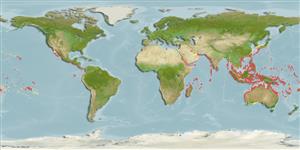Common names from other countries
Environment: milieu / climate zone / depth range / distribution range
Ecologie
marien; brak water rifbewoner; diepte 0 - 20 m (Ref. 48637). Tropical
Indo-Pacific: East Africa to Samoa and the Hawaiian Islands.
Grootte / Gewicht / Leeftijd
Maturity: Lm ? range ? - ? cm
Max length : 7.5 cm TL mannelijk / geslacht onbekend; (Ref. 11344)
Korte beschrijving
Determinatiesleutels | Morfologie | Morfometrie
Dorsale stekels (totaal) : 7; Dorsale zachte stralen (totaal) : 9; Anale stekels: 1; Anale zachte stralen: 8. Brown with irregular spots; dorsal and caudal fins with bands in females, dusky in males; often with dark brown saddle below each of the dorsal fins (Ref. 2798); characterized further by having upper five pectoral rays with free tips and sixth ray partly free; three branches on upper four pectoral rays; rounded caudal fin; longitudinal scale series 37-38; predorsal scales 18-20, reaching or nearly reaching interorbital space; cheek and opercle without scales; presence of fleshy double flap from edge of cheek into notch at posterior end of upper lip; ctenoid body scales, becoming cycloid on abdomen, breast, base of pectoral fin and nape; depressed head, width greater than depth; depth of body 4.3-5.5 in SL (Ref. 90102).
Inhabits intertidal seaward reef flats (Ref. 37816, 48637). Also found in shallow reefs near shore (Ref. 90102).
Levenscyclus en paargedrag
Maturities | Voortplanting | Spawnings | Egg(s) | Fecundities | Larven
Benthic spawner.
Randall, J.E. and M. Goren, 1993. A review of the gobioid fishes of the Maldives. Ichthyol. Bull. J.L.B. Smith Inst. Ichthyol. (58):1-37, 5 pls. (Ref. 9360)
Status op de Rode Lijst van het IUCN (Ref. 130435)
CITES (Ref. 128078)
Not Evaluated
Gevaar voor de mens
Harmless
Gebruik door de mens
Tools
Speciale rapporten
Download XML
Internetbronnen
Estimates based on models
Preferred temperature (Ref.
115969): 24.2 - 29.3, mean 28.2 (based on 3609 cells).
Fylogenetische diversiteitsindex (Ref.
82804): PD
50 = 0.5000 [Uniqueness, from 0.5 = low to 2.0 = high].
Bayesian length-weight: a=0.01023 (0.00477 - 0.02194), b=3.02 (2.84 - 3.20), in cm Total Length, based on LWR estimates for this (Sub)family-body shape (Ref.
93245).
Trofisch niveau (Ref.
69278): 3.4 ±0.5 se; based on size and trophs of closest relatives
Weerstandsvermogen (Ref.
120179): Hoog, minimale populatieverdubbelingstijd minder dan 15 maanden (Preliminary K or Fecundity.).
Fishing Vulnerability (Ref.
59153): Low vulnerability (10 of 100).
